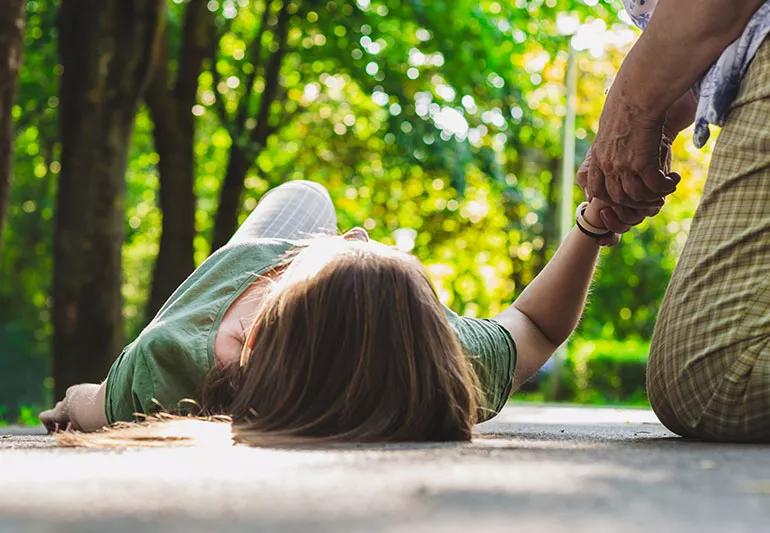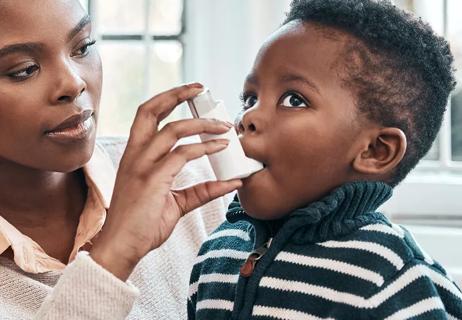A Q&A to prepare you and your child for syncope and its associated seizures

Fainting (syncope) in children is surprisingly common. In this Q&A, pediatric epilepsy expert Ajay Gupta, MD, explains what parents should watch for, the differences between fainting and seizures and six ways to prevent syncope in children.
Advertisement
Cleveland Clinic is a non-profit academic medical center. Advertising on our site helps support our mission. We do not endorse non-Cleveland Clinic products or services. Policy
A. Syncope, pronounced “SIN-ko-pea,” is the medical term for fainting. When a child faints, the blood supply — and the oxygen that blood brings to the brain — is temporarily reduced. This causes the child to lose consciousness, sometimes fall, and in severe cases, have a short seizure.
Syncope typically occurs in children during their pre-teen and teen years. It can also happen earlier, but that’s less common.
Children usually outgrow syncope. Most teens have no significant disability or restrictions from it.
A. Kids faint because of the reduced blood supply to their brain. Triggers for this reduction in blood supply include:
There are also rare types of syncope where kids faint when they:
When a child faints, it’s usually due to several factors. For example, let’s say a teen who’s already thin and didn’t sleep well at night. In the morning, he doesn’t eat or drink anything, goes to school and stands in line for some project. It’s hot, so he sweats a little bit, and then the teacher shows his class some biology experiment that’s a little scary.
Advertisement
That’s a perfect scenario for a fainting spell. It’s usually multiple things combined that lead to fainting.
A. Some estimates say 20% of children will experience at least one fainting episode before adolescence ends. Syncope is a common reason why children faint or feel dizzy. But it’s underdiagnosed. Near syncope and mild syncope, less severe types of syncope, often go unnoticed until the child ends up in the emergency room after a bigger event.
A. Some children are genetically more prone to fainting than others. For example, research has connected some types of neurocardiogenic syncope to genes. It’s the most common cause of fainting in children.
Neurocardiogenic syncope (vasovagal syncope) in children is when they faint because their body overreacts to something that distresses them. Their experience and emotions cause the brain to send a signal to the heart, causing the heart to start pumping slowly. Then their blood pressure drops, the brain blood supply drops, and they drop.
Vasovagal syncope can happen when a child watches a movie with some blood, violence or other scary visual. Some kids pass out when they go to the doctor’s office to get an immunization or blood test. That’s enough for them.
There are many genetic factors, but usually environmental factors affect these vulnerable children as well. But some can avoid syncope by following good precautions.
A. Signs that your child may be about to faint include:
They may even say, “I’m going to pass out.”
A. Syncope has a spectrum:
If a seizure does happen, it’s typically short and does not become anything complicated. If these children learn how to take care of themselves to avoid fainting, they won’t have another seizure.
A. Anyone who loses blood and oxygen supply to the brain can have seizures. But these seizures tend to be short, and children recover quickly. They won’t have any symptoms following the seizure. They also won’t have another seizure during the same episode.
Advertisement
But when a child has seizures that occur habitually and out of the blue, we often diagnose them with epilepsy (seizure disorder). Seizure disorders have nothing to do with blood supply and brain oxygenation. In this condition, a portion of the brain is irritated and fires rapidly, outside of its normal patterns.
The type of seizure depends on which part of the brain is firing abnormally. For example, if the seizure involves the right side of the brain, the child may have jerks on the left side of their body. If the seizure comes from the back of the brain on the right side, the child might have symptoms involving vision on the left side.
A. The child’s medical history is critical. So is their environment. We go over these details, do a physical exam and find out if they have any risk factors for epilepsy.
Finally, if we’re still not sure, these diagnostic tests can help:
Before we say it’s syncope, we have to make sure their heart is OK. There could be an undiagnosed heart rhythm disorder or structural defect. Similarly, we have to rule out seizures and other neurological conditions before we say it’s syncope.
Advertisement
A. These six tips can prevent syncope in children:
Advertisement
A. If they lose consciousness from fainting, a seizure or anything else, they should see a doctor. It’s never normal for a child to lose consciousness without reason. We should see every child at the time of their first symptoms, so we can evaluate them and make a plan, depending on the severity of the condition.
Treatments for syncope and seizures are very different. So it’s important for doctors to do their due diligence, including the proper follow-up, examinations and testing when needed. You want the earliest possible diagnosis of epilepsy so you can start treatment.
Learn more about our editorial process.
Advertisement

The emergency room is for serious medical issues; urgent care can help when you can’t get a quick appointment with your child’s doctor

An allergist can help you make a plan that includes information about what to do in case of an allergic emergency

Lead with empathy, involve other caregivers, and teach them how insulin helps them live a long and healthy life

Early weight gain can lead to health issues like heart disease, diabetes and cancer

Severe and debilitating headaches can affect the quality of your child’s life

Asthma-proof your home, keep notes and (try to) be patient with long-term treatments

Talk to your pediatrician; early treatment is key

Why kidney stones in kids are on the rise (and what to watch for)

The best parenting style balances enforcing rules and showing plenty of love

Tips include cutting back on sugar, focusing on exercise and managing stress

It can be harder to let go when you’ve invested time, energy and emotions — but it might be the healthier choice long term